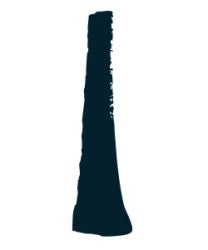Walter Dusenbery For Adolescents

Pedogna
Walter Dusenbery
Subject: Contrasting textures
Activity: Create assembled pieces from found texture samples
Materials: Different texture samples; for example, sandpaper, soda cans, leaves, cotton balls, stones, clay, etc., and adhesive
Vocabulary: contrast, interstice, texture, travertine
Walter Dusenbery was born in Alameda, California, in 1939. He studied at the San Francisco Art Institute and then the California College of Arts and Crafts, where he received a Master’s of Fine Arts (MFA) degree. Dusenbery’s favorite material was travertine, a kind of stone that is easily cut. In its pure state, travertine is white, but impurities can make it look yellow, red, brown, gray, and green. Some travertine deposits have solid impurities, including tiny fossils.
The title of this sculpture refers to the quarry in Tuscany, Italy, from which the stone came. The term “travertine” derives from the Latin name of the place in Italy that provided the ancient Romans with the stone used to build the Coliseum. Pedogna has two kinds of surfaces: a smooth, round, and bell-shaped base with rough interstices. The contrast between roughness and smoothness lends visual interest.
Why do you think Dusenbery named his sculpture after a quarry in Italy?
Why would it be important where the stone was from?
How would you describe the different textures you see?
How would the textures be different if this sculpture were made of wood or metal?
Collect different texture samples, for example, clay, cotton balls, leaves, sandpaper, soda cans, and stones.. Choose a way to assemble your objects. You might choose to use glue, wire, or string. Think about how the different textures create contrast. What else besides texture can create contrast? Color? Weight? The object’s purpose?
Dusenbery worked for a time as a studio assistant to the very famous Japanese American sculptor Isamu Noguchi.
Pedogna by Walter Dusenbery and Untitled (Seven Mountains) by Ursula von Rydingsvard were both made by stacking.
Compare the two sculptures. Why do you think the artists chose this method to make their sculptures?
Contrast -two or more unlike elements (as color, tone, or emotion) in the same work of art
Interstice - a space between things, especially one between closely spaced things
Texture - the visual or tactile surface of something
Travertine - a mineral consisting of layered calcium carbonate formed by deposits from spring waters, especially hot springs
